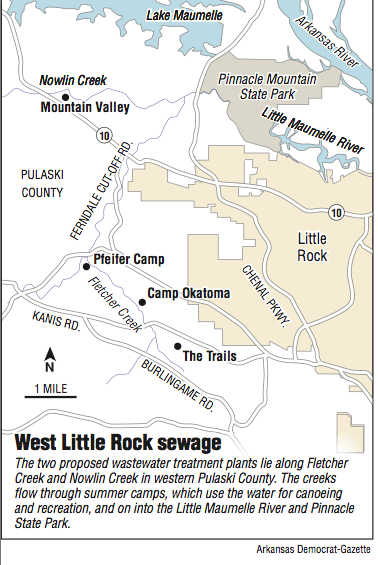The Little Rock Planning Commission will consider a conditional use permit for a private sewage treatment plant that would discharge 40,000 gallons of treated wastewater into Nowlin Creek daily.
The application for the treatment plant was submitted by developer Rick Ferguson and is intended to provide sewage services for his proposed 134-lot Mountain Valley Subdivision along Arkansas 10.
The proposal has caused consternation among residents concerned over how the discharge could affect the creek, which cascades through many residents' properties and feeds into the Little Maumelle River. Last week the commission fielded dozens of letters opposing the treatment plant from members of the Nowlin Creek Neighborhood Association. One of the group's primary concerns is how the discharge could threaten swimming in the creek.
The planning commissioners are scheduled to meet at 4 p.m. Thursday at Little Rock City Hall.
The commission's decision Thursday will provide insight on how Little Rock plans to regulate development in noncity areas of the county where the city has zoning authority over county residents' properties.
Similarly, along Fletcher Creek, another developer is poised to submit a permit application for another private sewage plant for a 266-lot subdivision should the commission approve the zoning permit Thursday. That project is also being opposed by the Citizens of West Pulaski County, a neighborhood group composed of roughly 400 members.
Ferguson, who did not return requests for comment, will also be required to gain approval from the Arkansas Department of Health and the Arkansas Department of Environmental Quality, which is responsible for upholding water quality standards set by the federal Clean Water Act.
Treated wastewater standards limit the effluent to the appropriate standard for swimming, according to the agency. The department also requires all treatment plants to test effluent at the discharge point regularly. The sampling required by the agency includes several factors including dissolved oxygen, pH, total suspended solids, and fecal coliform.
Whether the treatment plant would pose a danger to swimmers is unknown. The Department of Environmental Quality does not have monitoring stations along Nowlin Creek and, because the creek's watershed area is less than 10 square miles, the department does not technically designate the creek for swimming.
However, wastewater treatment discharge permits issued by the department limit effluent to standards that are safe for swimming.
"We are concerned about the sewage treatment plant discharging this treated sewage into Nowlin Creek that borders our land and that it will not be monitored, maintained and regulated in a timely fashion," Nicolas and Marcia Finn wrote in a letter submitted to the city last week. "Our grandchildren play in this creek and we are tremendously concerned for their safety."
Bruce Shackleford, an environmental consultant hired by the Citizens of West Pulaski County to investigate how a treatment plant would affect the county's waterways, explained how the treatment plants being espoused by developers are prone to failures.
"A lot of those little wastewater plants do not have a completely compliant track record," Shackleford said. "Oftentimes one of the major parameters that they violate is fecal coliform. Some of the more common fecal coliform violations are hundreds of times higher levels than the permit limit."
State Rep. Andy Davis, R-Little Rock, is a vendor of wastewater treatment plants, and he is involved with the development of the 266-lot subdivision along Fletcher Creek.
"In layman's terms, the way I like to explain it is: In general, the discharge has to be cleaner than the water it's going into," said Davis. "ADEQ [the Arkansas Department of Environmental Quality] cannot permit a system that would allow any degradation of the water quality that already exists in a stream."
Davis' district includes a large swath of western Pulaski County. In 2013, Davis passed legislation that changed the state's interpretation of the Clean Water Act and eased pollutant restrictions on waterways "that do not have an existing domestic water supply use," read the bill's text.
Upon learning of the legislation, the federal Environmental Protection Agency determined that the bill contradicted the Clean Water Act and terminated the state's authority to review minor-water-discharge permits.
Members of the citizen groups also fear that if these treatment plants are approved and the large, dense subdivisions follow, it would open up the western side of the county to rapid development.
"I can see 15 of these subdivisions right here in the next 10 years. They'll start throwing these things up 200 houses at a time and it's not thought out," said Walter Smiley, a member of the citizens group who owns 25 acres in the county. "There's a combination of state, county and city regulations that have not been put together properly, and now suddenly there's this push to the west."
Metro on 07/13/2016
